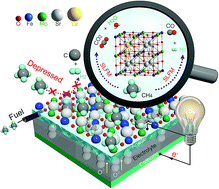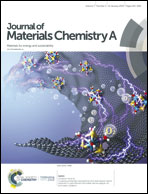Electron doping of Sr2FeMoO6−δ as high performance anode materials for solid oxide fuel cells†
Abstract
Electron doping in perovskites is an effective approach to design and tailor the structure and property of materials. In A2BB′O6−δ-type double perovskites, B-site cation order can be tunable by A-site modification, potentially leading to significant effect on the oxygen nonstoichiometry of the compounds. La3+-doped Sr2FeMoO6−δ (Sr2−xLaxFeMoO6−δ, SLFM with 0 ≤ x ≤ 1) double perovskites have been designed and characterized systematically in this study as anode materials for solid oxide fuel cells. Rietveld refinement of powder X-ray diffraction reveals a crystalline symmetry transition of SLFM from tetragonal to orthorhombic with the increase of La content, driven by the extra electron onto the antibonding orbitals of eg and t2g of Fe/Mo cations. An increase in Fe/Mo anti-site defect accompanies this phase transition. Solid oxide fuel cells incorporating the Sr1.8La0.2FeMoO6−δ (SLFM2) anode demonstrate impressive power outputs and stable performance under direct CH4 operation because of its altered electronic structure, desired oxygen vacancy concentration and enhanced reducibility. Density functional theory plus U correction calculations provide an insight into how La doping affects the Fe/Mo anti-site defects and consequently the oxygen transport dynamics.



 Please wait while we load your content...
Please wait while we load your content...
